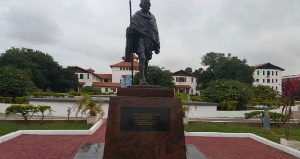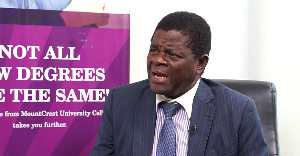A global debate has been brewing for sometime now about the place in history of certain individuals who have been immortalised in various ways- either on emblems or as statues.
Statues are of monumental importance. When they are standing- they do not stand for themselves. They stand for something. When they fall, it usually marks the end of an era.
When Jerry John Rawlings, the first President of the 4th Republic left office, a statue of him at the Eastern Regional capital of Koforidua was brought down. We watched the statue of Iraqi’s Saddam Hussein go down.
In recent times, the spotlight has been shone on statues and emblems on various universities across the world. We have seen the statue of Cecil Rhodes being taken off from the University of Cape Town; after protestors asserted that he was a racist and one of the people who prepared the way for apartheid to take root in South Africa.
Cecil Rhodes thought the English race was the master race. "I contend that we are the first race in the world and that the more of the world we inhabit the better it is for the human race," he once said.
The University of Cape Town was not the only place where discussions to remove the statues and emblems of historic importance were taking place. It was taking place in Princeton, Yale and Harvard.
In the specific case of Harvard, the law school’s emblem was the object of focus. The challenge with the emblem was summed up in an article in the Harvard Crimson; “The Harvard Law School crest is a glorification of and a memorial to one of the largest and most brutal slave owners in Massachusetts.
Isaac Royall, Jr, was more than simply a slave owner; he was complicit in torture and in a gruesome conflagration in which 77 black human beings were burned alive.”
Isaac Royall entered into the Harvard picture after his estate gave some part of his fortune to the Harvard University to establish a chair in law. Protest after protest led to the change in the school’s emblem.
Ghanaians are currently debating how to deal with the image and role of another figure – Mahatma Ghandi, whose statue is firmly rooted in a quadrangle in the University of Ghana.
Ghandi is a very popular character in Africa. I first encountered Ghandi during my studies in modern political philosophy and thought.
One of the texts we were required to familiarise ourselves with was Martin Luther’s “Letter from a Birmingham Jail.” It was a relatively easy read, especially after spending the previous semester trying to make sense of Aristotle, Plato, St Thomas Aquinas, St Augustine and their thoughts and ideas.
The letter from Birmingham jail was a letter from Martin Luther King Jnr addressed to the clergymen of his day. In there he attempts an explanation as to what informed his civil disobedience stance.
He explained that his style of civil rights movement was informed by the success that Ghandi had achieved. And indeed for many people, that became the prism through which they viewed Ghandi – the non-violent, resistance leader who changed the face of Indian politics.
But of course he was no saint. He had his flaws. He had his prejudices. He had his foolishness. In the latest protests aimed at taking down the statue from the University of Ghana, the main charge is that he was racist. He described blacks in derogatory terms. But he is definitely not the worst character in history.
There are some characters we can all agree that they should never ever have their names even printed on a cheap piece of paper because of the horrible and evil role that they played in history.
But here is the tricky one – that is the human condition. And that condition is that all human beings are flawed in one way or another. So many of such instances abound both in history and in literature. The protagonist almost always has a flaw or two.
Does Martin Luther King Jnr whose work I have just cited deserve to have a statue on a university campus? If you choose to look on the bright side, you may say yes with a thousand cheers. After all, his immense contribution to the civil rights movement stands out there for all to see.
For those who choose to look on the grim side, they may ask, “why should we have the statue of someone who is alleged to have plagiarised a substantial part of his doctoral dissertation?” It is a question of choice.
Anyone with some form of legal education would have heard of the admirable English judge, Lord Denning. He was revolutionary in his approach to the law. He made advances and decisions in which very few people could have dared to make. He was not a timorous soul.
One commentator said this of him: Lord Denning famously often took the side of the socially weaker party against the stronger. He backed deserted wives, wounded soldiers battling the government over pensions, customers arguing against banks.
He strongly argued dissents in the Court of Appeal - where his judgement was outweighed by the opinions of the two other judges with whom he was sitting - were the stuff of legend. In many cases, his dissentient opinion even won out, leading to the law being changed in line with his view”.
And yet, for all he had achieved, he could aptly be described as racist. He once stated, “British citizens were no longer all qualified to serve on juries because the English are no longer a homogenous race. They are white and black, coloured and brown…some of them come from countries where bribery and graft are accepted … and where stealing is a virtue so long as you are not found out.”
And what of Alfred Nobel, the man after whom the Nobel Prize was named? He made his fortunes through his invention of the dynamite and other explosive. When his brother died, a French newspaper accidentally put out an obituary of Nobel. The obituary said: "Le marchand de la mort est mort" ("The merchant of death is dead"). The obituary further stated, “Dr Alfred Nobel, who became rich by finding ways to kill more people faster than ever before, died yesterday.”
It was this reputation that compelled him to create the Nobel set of prizes. And a cynic would be right to say that it was all part of a stunt to improve upon his deplorable image.
The examples of “great men” with manifold flaws are abundant. Until we come to the conclusion that the human condition is flawed and that no one is perfect, we would be raving and raging at any and every statue that comes up.
After all, all have sinned and fallen short of the glory of God, so says the Bible.
Opinions of Saturday, 1 October 2016
Columnist: Samuel Alesu-Dordzi



















